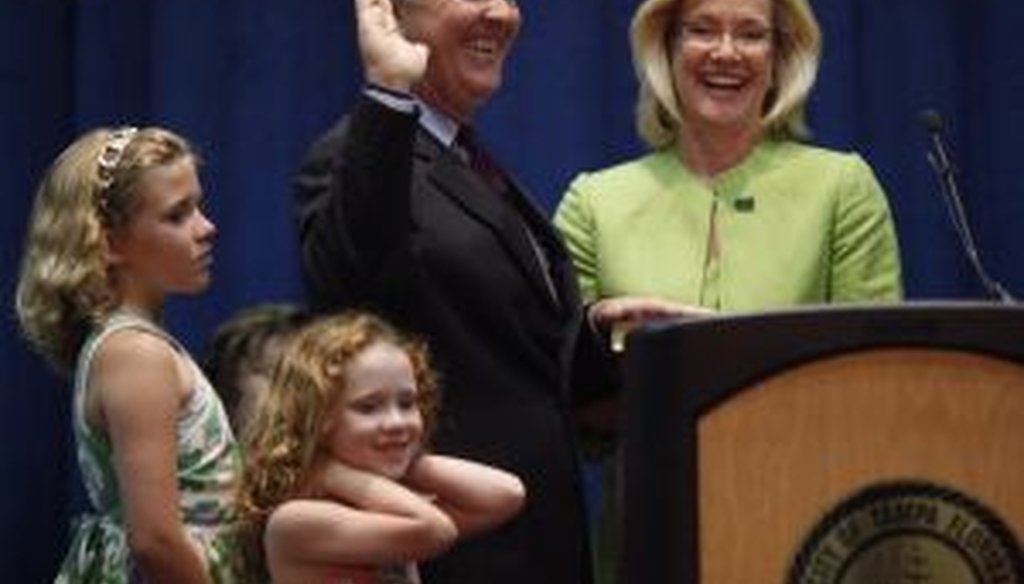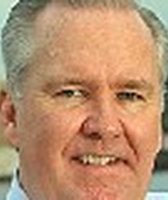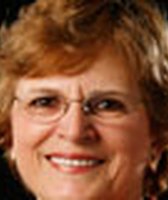Stand up for the facts!
Our only agenda is to publish the truth so you can be an informed participant in democracy.
We need your help.
I would like to contribute

Tampa Mayor Bob Buckhorn, pictured here with his family, was sworn in on April 1, 2011.
It’s been a busy 12 months for Mayor Bob Buckhorn, who marks one year in office Sunday and talks like he couldn’t be happier.
"It’s gone better than I had hoped," he says. "I have really enjoyed the sense of optimism I feel out there."
But is he keeping his promises?
The question goes to the heart of how Buckhorn, 53, won the race for mayor. Especially during the runoff, he touted his plan — called "Changing Tampa’s Economic DNA" — again and again. His promises often were unflinching in their boldness, clarity and fine-print detail.
That’s why PolitiFact Florida, the political fact-checking arm of the Tampa Bay Times, created the Buck-O-Meter.
Similar to PolitiFact’s Obameter for President Barack Obama and Scott-O-Meter for Florida Gov. Rick Scott, the Buck-O-Meter has identified 34 promises Buckhorn made during his campaign.
At the one-year mark, here’s the scorecard:
• 12 Promises Kept. Some were central to his priorities (naming a business task force to study ways to make Tampa more competitive; reorganizing City Hall to speed up permitting; coordinating waterfront development). Others were at the edge (planting 1,000 trees a year).
• 10 promises In the Works.
• Six promises Stalled.
• Four promises in a Compromise.
• Two Promises Broken. Buckhorn did not propose a ban on panhandling his first week in office, nor has he created incentive packages for high-tech industry during his first year.
In some ways, Buckhorn’s four-year term got off to a low-profile start as he wrestled with balancing the city’s $765.4 million budget. He did it by cutting 21 vacant positions, using $6 million in reserves and raising the franchise fee paid by Tampa Electric customers in the city by $1.50 a month.
Still, Buckhorn made a few headlines along the way.
On the future of the Tampa Bay Rays, he famously told St. Petersburg Mayor Bill Foster, "I’m not going to be the boyfriend in your divorce."
When a City Council member threatened to vote against Buckhorn’s budget unless the city fixed an inner-city pool, the mayor quipped, "I only need four votes," raising some eyebrows.
With a few days, however, the city said it would start repairs soon, and Buckhorn took pains to say the city had always planned to do the job.
In recent months, Buckhorn has started addressing campaign priorities at a faster pace. Before then, city finances were at the top of his list.
"We spent the first three to four months working on the budget, trying to close that $34.5 million deficit," he said.
•••
In some cases, the promises where the Buck-O-Meter rating is Compromise or In the Works illustrate what can happen when the rhetoric of the campaign encounters the reality of governing.
Take Buckhorn’s plan to create two deputy mayors, one for economic opportunity and the other for neighborhoods and community empowerment.
It was a centerpiece promise of his campaign, but one year in, Buckhorn doesn’t have any deputy mayors. He has, however, shuffled the ranks at City Hall to give two officials new responsibilities and, in one case, plenty of new authority.
In February, Buckhorn elevated Bob McDonaugh to the new job of administrator of economic opportunity.
In that job, McDonaugh oversees all city programs and divisions related to economic development and business regulation. His assignment is to focus on attracting new businesses to Tampa and growing and retaining existing businesses.
Buckhorn said McDonaugh’s new job is exactly what he promised during the campaign, just with a different title.
"Bob McDonaugh has every bit of responsibility that I’ve talked about for a year and a half," he said. But "because it’s more of an administrative slot, the title senior administrator just seemed to work better."
Ultimately, he said, Tampa voters simply want results.
"As long as I get done what I said I was going to do, what the person’s called doesn’t make any difference to them," he said.
On the neighborhood slot, Buckhorn named city budget officer Dennis Rogero the city’s new budget and neighborhood empowerment director, giving him responsibility for supervising neighborhood services.
"That was a case of splitting the baby," said Buckhorn, who said he wanted all departments that touch neighborhoods under one person. "What I’m not ready to do yet, and it’s largely a financial decision, is create a new slot.’’
In a third instance, Buckhorn pledged to create initiatives to improve parks. So far, he hasn’t gotten around to setting up that Parks Advisory Board he promised.
But he is working on illuminating bridges at night, landscaping the main entry ways to downtown and recruiting a restaurant to the old city Water Works Building on the Hillsborough River.
And on yet another promise, Buckhorn simply changed his mind.
Candidate Buckhorn promised to appoint a city director of protocol to focus on building international trade.
But once in office, he learned that the city already helps pay for someone to do that job out of the Greater Tampa Chamber of Commerce.
"I’ve decided I’m not going to do that," he said of the original promise. "In this economy, I didn’t want to add additional personnel if I could avoid it."
•••
The first year was a challenge.
The second will be harder by an order of magnitude.
First, next year’s budget could have another $30 million revenue shortfall. That has Buckhorn thinking about delaying capital improvement projects and looking at further hard-nosed cost controls.
After last year’s money-saving moves, "I don’t have a lot of low fruit left," Buckhorn said.
Still, that could be easy compared to the Republican National Convention, which could draw up to 15,000 protesters to Tampa from Aug. 27-30.
"It is the biggest event that the city has ever attempted to host," he says. "It’s a worldwide event ... at a time when national politics are ripe for conflict and confrontation."
During a televised debate during the race for mayor, Buckhorn was asked how he would balance the rights of citizens to protest during the convention with his responsibilities to keep downtown Tampa functioning and safe.
"People who want to express themselves need to be given an opportunity," he replied. "For me, it’s a very fundamental premise: you break the law, you’re going to jail. Absent that, you’re entitled to say whatever you want to say within reason."
Last week, Buckhorn’s administration unveiled a set of proposed protest rules for the convention that reveal more of the city’s thinking about how to strike this balance.
Here is its essence: Facilitate protests in a controlled area near the convention site. Allow parades and rallies in other parts of downtown, too, but require organizers to get permits and set a one-hour time limit. And enact temporary rules to ramp up security in and around downtown.
Buckhorn wants to create the protest zone near the Tampa Bay Times Forum, the site of the convention, though the zone’s exact location has not been identified.
The zone, which the city is calling a "public viewing area," would be open 24 hours a day, probably would be fenced, and protesters would be screened to keep out weapons. But it could also have water, portable toilets and access to a stage and microphone.
And while protesters couldn’t camp there, they could stay and demonstrate as long as they pleased.
Outside the protest zone, it would be a different story.
The city would allow groups of more than 50 to march only on an official parade route and to rally only at city parks. And to do so, they would need a city permit. Finally, no parade or rally outside the protest zone could last longer than 60 minutes.
The city also is looking at creating a "Clean Zone" covering downtown, Ybor City, the Channel District, parts of some nearby neighborhoods, plus Harbour Island and Davis Islands.
Inside that zone, a variety of items that could be used as weapons would be banned.
Buckhorn said police are training intensely to be ready for trouble without over-reacting.
"It’s a high-wire act," he said. "Will we do everything right? Probably not, but it won’t be because we haven’t trained and practiced and because we don’t go at this with the best of intentions."
Our Sources
See individual promises for complete sources.






























